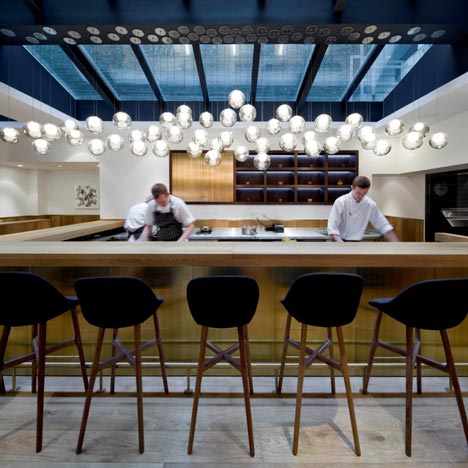Clustered pendant lights are suspended over one of the open food and drink preparation areas of this London restaurant by Chinese designers Neri&Hu.
The open-plan Pollen Street Social restaurant bridges together two previously separate buildings, spread out across the ground floor and basement.
Dining areas are furnished with wood panelled tables and booths, Chesterfield-inspired leather sofas and green glass lamps.
On the basement level, diners can see into the kitchen through a long horizontal slot window.
More restaurants and bars on Dezeen »
Photographs are by Pedro Pegenaute.
The following information is from Neri & Hu (NHDRO):
Recently completed: Pollen Street Social
Pollen Street Social, located in the prestigious Mayfair district of London, is the first independent restaurant by Jason Atherton, the Former Executive Chef at Gordon Ramsay’s Michelin starred Maze. Shanghai-based architectural firm Neri&Hu are the designers for the restaurant and Pollen Street Social represents their first completed project in London.
The term Social always refers to the interaction of organisms with other organisms and to their collective co-existence, irrespective of whether they are aware of it or not, and irrespective of whether the interaction is voluntary or involuntary. –Wiktionary
Neri & Hu’s design concept for Pollen Street Social examines the notion of “social” as a reorganization of the dynamic energies of human interaction.
Like navigating a conversation, the architectural spaces steer and negotiate the social relationships not only amongst guests, but also between diners and their food as it is prepared and served.
Within the confined basement and ground floor spaces of two disjointed historic buildings, the architects have woven a series of these social spatial experiences, from the Bar to the Main Dining Room or Private Dining Room to Atherton’s signature Dessert Bar. Placing those other functions such as the Show Kitchen, Service Station, and Back of House into strategic containers, the guests occupy the space in-between, a fluid zone celebrating the theatrics of eating, drinking, and socializing.
As with the start of any conversation, it is appropriate to begin with a gesture of courtesy, and Neri & Hu’s design for the restaurant’s façade is indeed a nod towards the historic structures surrounding the site. A series of blackened bronze metal frames act as a stitching strategy, redefining the restaurant's threshold with a modern touch while maintaining the proportions and details of the existing façade. Within these frames, a combination of transparent and translucent glass ensures visual continuity between diners and the life of the street beyond.
Within the restaurant’s ground floor spaces the inviting atmosphere is reminiscent of entering the chef’s own home, and feels as easy as falling into familiar dialogue with an old friend. Through contemporary and abstracted re-interpretations of Old English details—the continuous wood wainscot wrapping each space, the Chesterfield-inspired banquettes, or the green glass P-Lamps at the bar—Neri & Hu has crafted an ambiance that is at once casually domestic yet still retaining the elegance of fine dining.
Dramatic ceiling openings above flood the spaces with light and mark special dining areas, while jeweled pendant lights scattered throughout captivate the eye as food delights the palate.
There is just the slightest pause in the flow of drinks and conversation as dining guests notice, through carefully carved apertures and aligned views, the stage that has been set in this theatrical dining experience. Through the architects’ willful juxtaposition of the disparate realms of food preparation and food consumption, such as the Finishing Kitchen just behind the Dessert Bar or the Service Station placed front and center in the Main Dining Room, these various spaces come alive as contradictions abound. The actions before them—the carving of an Iberico ham, the dabbing of sauce upon a plate, the practiced swirl of decanting wine—are initially, silently performed for their voyeuristic gaze, but then, with the first bite, the tables are turned and it is the diner that is now practicing a slow and deliberate choreography.
Like a chance encounter, the basement level is a pleasant discovery with its distinctive material palette of weathered brick floors and glass display cases. The Private Dining Room features wine fridges enveloping its perimeter, providing an enclosed yet visually open environment for intimate gatherings. A slotted view across the corridor into the Working Kitchen deliberately frames the hands of the chefs and pays homage to their skillful mastery of fine cuisine.
The restrooms on this level are contained within a frosted-glass enclosure with varying degrees of transparency, allowing glimpses of shadowy silhouettes and providing a moment of thrill and audacity. And as a final twist, the restrooms stalls themselves, clad solidly in wood, offer a chance to escape completely and disconnect entirely, should the anxieties of socializing overwhelm.
With their masterful manipulation of spatial elements and materiality, architects Neri & Hu have captured the vibrancy of a social dining atmosphere as envisioned by Chef Atherton—it flows with comfort and familiarity, while occasionally improvisational and unexpected, but which ever direction the conversation turns, Pollen Street Social is sure to be the talk of town.
The custom furniture and accessories pieces featured in the interiors are from neri&hu editions, a product brand spin-off from the architectural firm.

